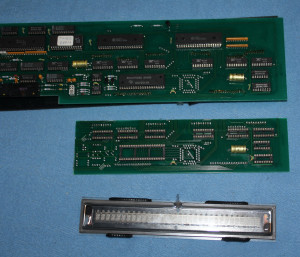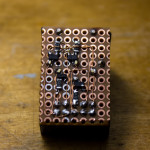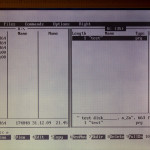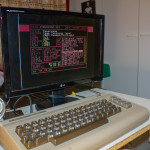 Canon X-07 is great little handheld retro computer. But being Canon, nothin is standard. Canon has always insisted using weird proprietary connector for devices, and usually it is impossible to find connectors that would fit them. This is also a case with X-07. It uses weird connectors for serial- and parallel ports. They look bit like a normal D-sub connector, and D-sub connector almost fits into them, but it is not a good fit. I wanted to make new connector that matches X-07’s serial port perfectly, so I took my callipers and 3D cad and started to work. Read More …
Canon X-07 is great little handheld retro computer. But being Canon, nothin is standard. Canon has always insisted using weird proprietary connector for devices, and usually it is impossible to find connectors that would fit them. This is also a case with X-07. It uses weird connectors for serial- and parallel ports. They look bit like a normal D-sub connector, and D-sub connector almost fits into them, but it is not a good fit. I wanted to make new connector that matches X-07’s serial port perfectly, so I took my callipers and 3D cad and started to work. Read More …
Category: Build
Swapping RJ12 to SMA
 I have old but trusty Thinkpad X200s laptop that is now retired but still occasionally used. Due being s model, it does not have build in 3G/WWAN antennas in display because there is no space for them. Independent internet connectivity is often useful, especially in places where there is no WiFi or good cell coverage.
I have old but trusty Thinkpad X200s laptop that is now retired but still occasionally used. Due being s model, it does not have build in 3G/WWAN antennas in display because there is no space for them. Independent internet connectivity is often useful, especially in places where there is no WiFi or good cell coverage.
Like many business notebooks, my Thinkpad still had 56k modem and land line RJ12 connector, which isn’t that useful in most western countries where POTS and analog modem services have long being discontinued.
Sunrise lamp add-on for nixie alarm clock.
 Finnish winter days are dark and cold. The sun rises only for short moment, and even then it is often cloudy, or the sun is so low that it can rarely be seen. A circadian clock is synchronized with daylight changes, and so without external stimulus from sunlight, my daily rhythm started to lag and spin around. Waking at morning was difficult task.
Finnish winter days are dark and cold. The sun rises only for short moment, and even then it is often cloudy, or the sun is so low that it can rarely be seen. A circadian clock is synchronized with daylight changes, and so without external stimulus from sunlight, my daily rhythm started to lag and spin around. Waking at morning was difficult task.
There is a ready-made solution for this, e.g. Philips does sell alarm clocks with build in wake-up lamps, that turn on at morning to artificially sync humans internal clock. Me being hacker, I had to make my own solution, as usual. Read More …
C64 XA1541 Cable
The XA1541 cable is adapter often used to connect C64s 1541 floppy drive to more modern PC equipment. It connects to PC parallel port, and special software bitbangs IEC commands and data to 1541 drive. Old 386 laptop is used due lack of parallel port in modern computers.
VFD Returns!
 I dug out my old VFD display project. This time I got some text showing up and prototype ready to be even bolted in some enclosure. I started with sawing piece of from original display controller as I didn’t bother to make PCB to house VFD screen, and all needed IC:s and connections were already there. Removing piece from 2mm fiberglass board is not easy task when your only tools are couple of hobby knives. But sawing boards with hacksaw would have caused more nasty fiberglass mess. Read More …
I dug out my old VFD display project. This time I got some text showing up and prototype ready to be even bolted in some enclosure. I started with sawing piece of from original display controller as I didn’t bother to make PCB to house VFD screen, and all needed IC:s and connections were already there. Removing piece from 2mm fiberglass board is not easy task when your only tools are couple of hobby knives. But sawing boards with hacksaw would have caused more nasty fiberglass mess. Read More …
UART to RS232 voltage level shifter
 Sometimes I find myself in need of interface some old tech that uses legacy RS232 interface. The thing is today’s computers and other smart logics do not have real TIA-232 compliant serial ports. The RS232 standard uses voltage levels that range from ±3V to ±15V, and space between -3V and +3V is defined as not valid. And a logic 1 is transmitted as negative voltage.
Sometimes I find myself in need of interface some old tech that uses legacy RS232 interface. The thing is today’s computers and other smart logics do not have real TIA-232 compliant serial ports. The RS232 standard uses voltage levels that range from ±3V to ±15V, and space between -3V and +3V is defined as not valid. And a logic 1 is transmitted as negative voltage.
Even though use of RS232 ports are seldom use anymore, an asynchronous serial communication is not dead. Many embedded systems use it as debug interface. Also some devices still use it as communication interface, even if physical layer is implemented with USB or Bluetooth. Read More …
VFD Schematics & code witchcraft
I have yet published basic schematics and code for display project.  Atmega 16 work as display controller. It will read data from uart serial port, place it to text buffer and simultaneously multiplex display trough segment voltage buffers and huge digit shift register. ASCII text is converted to segment data and font can be created with computer program. Read More …
Atmega 16 work as display controller. It will read data from uart serial port, place it to text buffer and simultaneously multiplex display trough segment voltage buffers and huge digit shift register. ASCII text is converted to segment data and font can be created with computer program. Read More …
VFD Time!
Hello, I’m Ketturi Fox, and I’m addict. Yes, I have VFD addiction, Vacuum Fluorescent Displays, I mean. I have big box of them, waiting for appropriate project (which probably will never come). This time I found big nice displays from old digital scale.
Dual buck converter
I had boring day, and was too lazy to do school works, so what else I could do but electronics? For next project I need power supply and due to poor efficiency of linear regulators, I choose to make an another switching regulator.
 And there is the blurry picture. Similar construction to the nixie clock’s power supply, but this time double. Read More …
And there is the blurry picture. Similar construction to the nixie clock’s power supply, but this time double. Read More …
Itty Bitty Buck converter
Everybody knows old 78xx linear regulators. They are ok for many applications, but are problematic for bigger currents. They drop and regulate voltage smoothly for circuitry, but because all excess voltage are dissipate as heat, they are very inefficient. For my nixie clock I needed efficient little power supply for 5V rail, so I created this little baby:
Mainboard for nixie clock and burned fingers
Finally I got time to continue the nixie clock. This week is the annual autumn break so hopefully I can make most parts of the clock ready. Writing program code is so time consuming that it is necessary to leave it for a later time. Yesterday I started to assemble the mainboard for the clock. It went mostly without any problems (I dropped my N900 phone which broke down and burned my fingers as usual), and I finished it tonight.
























